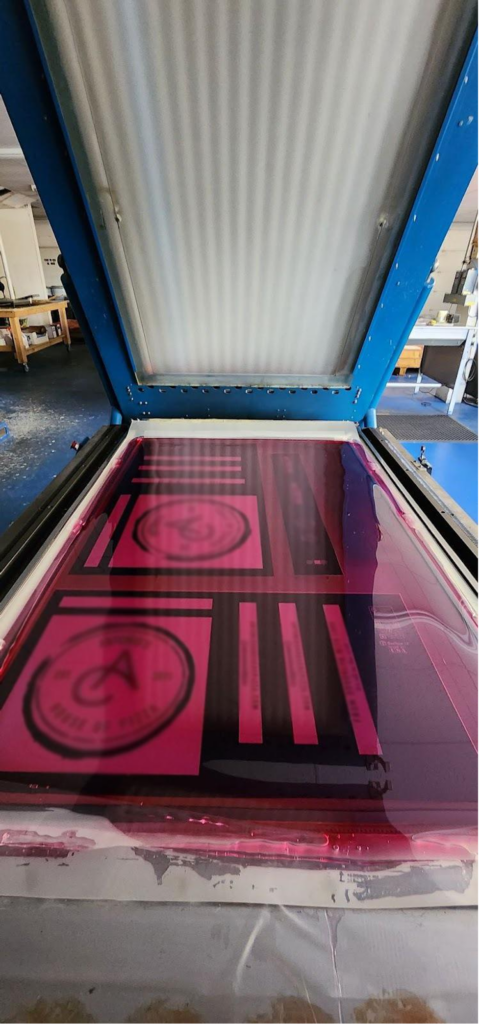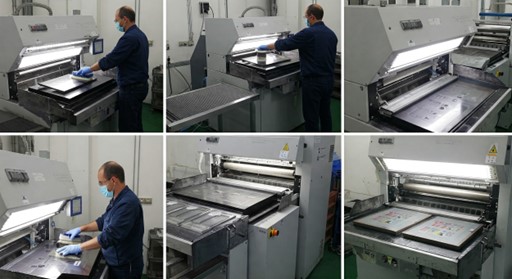Proper maintenance of the exposure unit glass is essential for ensuring the production of high-quality photopolymer printing plates. Over time, the matte finish on the upper and lower frame glasses can become contaminated, leading to issues with vacuum seals and the quality of the final plates. Here’s a detailed guide on how to clean the exposure unit glass effectively.
Why Cleaning Exposure Unit Glass is Important
The matte finish on the exposure unit glass is crucial for maintaining a proper seal between the cover film and the lower glass, as well as between the substrate and the upper glass. Contaminants such as dust, cleaning agents, tack rag residue, and resin can fill in the matte finish, causing the glass to turn clear and preventing air from escaping. This results in poor vacuum seals and defects in the plates, such as dime-sized low spots or zebra patterns
Cleaning Procedure
Materials Needed
- Lint-free towels
- Soft scrub solution or powder
- Sponge with Scotch-Brite on one side
- Protective gloves
- Safety glasses
- Two buckets of clean, warm water
- Glass cleaner
- Alcohol
Step-by-Step Process
1. Open the Upper Frame: Open the upper frame of the machine
2. Turn Off the Unit: Turn off the unit at the main power supply.
3. Protect the Lower Frame: Cover the lower frame area to prevent spills and make cleanup easier.
4. Initial Cleaning:
• Wear protective gloves and safety glasses.
• Spray the glass with glass cleaner.
• Using a sponge soaked in warm water, apply the soft scrub solution to the Scotch-Brite surface.
• Clean the entire glass surface using small circular motions.
• Rinse the sponge in a
5. Rinse and Wipe Down:
• After cleaning, wipe down the glass surface with a lint-free towel to remove the cleaning solution residue.
• Clean the glass again with a glass cleaner using a lint-free towel.
• Use alcohol-soaked, lint-free towels to perform a final cleaning of the glass surface.
6. Inspect and Repeat if Necessary:
• Once the glass dries, it should have a matte look. If not, repeat steps 1-5
7. Lower Glass Cleaning: Follow the same process for cleaning the lower glass, covering the vacuum lines with masking tape to prevent liquids from entering the vacuum system.
8. Contact Technical Support: If the glass is still not clean, contact your local Anderson and Vreeland Technical Service Representative. They can perform an additional procedure called “lapping,” which uses a special tool to clean the crevices of the glass.
9. Safety Reminder: Read and follow the safety recommendations for the materials used in the cleaning process.
Lamp Output on Exposure Units
Lamp intensity in exposure units is critical for producing high-quality AVantage® photopolymer printing plates. Low-intensity lamps affect the quality of the plates and the finishing steps during processing. The life and performance of lamps depend on various factors, including the type of exposure unit, lamp type, operational temperature, number of cycles, total hours, and the cleanliness of the bulb surface.
Types of Exposure Units and Lamp Requirements
3040/3048 Units
- Upper Frame: High output UV lamps at 350 nm (3.0 – 6.5 mW/cm²).
- Lower Frame: High output UV lamps (4.0 – 6.5 mW/cm²).
- Special Units: Higher intensity 370 nm lamps (4.0 – 8.0 mW/cm²).
4460/5280 Units
- Upper Frame: 350 nm lamps (2.0 ± 0.5 mW/cm²).
- Lower Frame: High-intensity 370 nm lamps (4.0 ± 0.5 mW/cm²).
- Replacement Thresholds: Upper frame lamps should be replaced below 1.2 units, lower frame lamps below 2.5 units.
Post-X Units
- Lamp Output: 370 nm reflective high-intensity bulb (20.0 ± 1.0 mW/cm²).
- Replacement Threshold: Lamps should be replaced below 10.0 mW/cm².
Cleaning and Maintenance
- Clean lamps quarterly to improve intensity and performance.
- Use lint-free towels and Windex® or similar cleaning solution.
- Clean the upper and lower frame glasses periodically for better performance.
Post Exposure Conditions
The post-exposure step is crucial for producing tack-free AVantage® photopolymer printing plates. Factors affecting post-exposure include salt concentration, lamp intensity, exposure time, and bath cleanliness.
Post-X Salt (AVESalt) Bath Concentration
- 3040/3048 Unit: 1 lb per day
- 4460 Unit: 2.5 lbs per day
- 5280 Unit: 3.5 lbs per day
Mixing and Maintenance
- Pre-dissolve the Post-X salt in water and pour it into the bath.
- Ensure the bath water level covers the plate completely.
- Replace bulbs when their intensity falls below seven mW/cm².
Recommended Post-X Exposure Times
- 9.0 mW/cm² or higher: 15 minutes
- 8.0 – 9.0 mW/cm²: 20 minutes
- 7.0 – 8.0 mW/cm²: 25 minutes
By following these detailed cleaning and maintenance procedures, you can ensure optimal performance and longevity of your exposure unit glass and lamps, resulting in high-quality photopolymer printing plates.
Maintaining Exposure Unit Glass
Proper maintenance of the exposure unit glass is vital for producing high-quality photopolymer printing plates. By adhering to these detailed cleaning and maintenance procedures, you can ensure optimal performance and longevity of your exposure unit glass and lamps. This will help you achieve superior results in your printing processes.
For expert guidance and top-tier products, contact Anderson & Vreeland today.
Call us at (866) 282-7697


